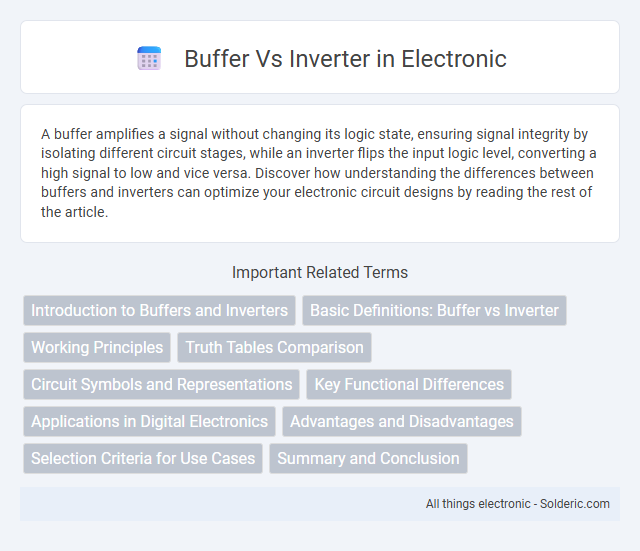A buffer amplifies a signal without changing its logic state, ensuring signal integrity by isolating different circuit stages, while an inverter flips the input logic level, converting a high signal to low and vice versa. Discover how understanding the differences between buffers and inverters can optimize your electronic circuit designs by reading the rest of the article.
Comparison Table
| Feature | Buffer | Inverter |
|---|---|---|
| Function | Passes input signal unchanged | Inverts input signal logic level |
| Output | Same as input (1 - 1, 0 - 0) | Opposite of input (1 - 0, 0 - 1) |
| Use Case | Signal strengthening, noise reduction | Logic inversion, NOT gate functionality |
| Symbol | Triangle without inversion bubble | Triangle with inversion bubble |
| Delay | Minimal signal propagation delay | Minimal signal propagation delay |
| Power Consumption | Low | Low |
| Typical Application | Driving long wires, buffering signals | Logic circuits, control signal inversion |
Introduction to Buffers and Inverters
Buffers and inverters are fundamental digital logic circuits used to manipulate signal states in electronic systems. A buffer amplifies the input signal without changing its logical state, ensuring signal integrity and driving capability. An inverter, also known as a NOT gate, reverses the input logic level, converting a high input to low output and vice versa, which is essential in logic circuit design.
Basic Definitions: Buffer vs Inverter
A buffer is a digital circuit that outputs the same logic level as its input, providing signal amplification and isolation without changing the signal state. An inverter, also known as a NOT gate, outputs the opposite logic level of its input, converting a logical '1' to '0' and vice versa. Both components are essential in digital electronics, with buffers enhancing signal integrity and inverters enabling logical negation.
Working Principles
A buffer operates by amplifying the input signal without altering its logical state, ensuring signal strength is maintained across circuits. An inverter, however, reverses the input logic level, outputting a high voltage when the input is low and vice versa. Understanding these working principles helps you select the appropriate component for signal conditioning or logic manipulation in digital circuits.
Truth Tables Comparison
The truth table of a buffer shows that the output always matches the input, with input 0 yielding output 0 and input 1 yielding output 1. In contrast, the inverter's truth table reverses the input state, producing output 1 for input 0 and output 0 for input 1. This fundamental difference highlights the buffer's role in signal stabilization and the inverter's function in signal negation.
Circuit Symbols and Representations
The circuit symbol of a buffer is a triangle pointing to the right without any additional markings, representing a device that outputs the same logical state as its input to strengthen signal integrity. An inverter, also known as a NOT gate, is symbolized by a triangle pointing right followed by a small circle, indicating the inversion of the input signal from high to low or vice versa. Understanding these distinct symbols helps you correctly interpret and design digital logic circuits by clearly identifying signal preservation versus signal inversion functions.
Key Functional Differences
A buffer amplifies and stabilizes a signal without altering its logic state, ensuring signal integrity and drive capability across circuits. An inverter reverses the input logic level, outputting a high signal when the input is low and vice versa, effectively performing a NOT operation. Buffers are used to strengthen signals for further stages, while inverters are critical in logical operations and signal toggling.
Applications in Digital Electronics
Buffers are widely used in digital electronics to enhance signal strength and isolate different circuit stages, ensuring reliable data transmission without altering the logic state. Inverters serve critical functions such as implementing logical NOT operations, generating complementary signals, and creating oscillators or timing circuits. Your choice between a buffer and an inverter depends on whether you need signal buffering or logical inversion in your digital design.
Advantages and Disadvantages
Buffers provide signal amplification and isolation, improving driving capability and reducing signal degradation in digital circuits, but they do not change the logic state, limiting their use in logic manipulation. Inverters invert the input signal, offering essential logic functionality for implementing NOT operations and signal inversion, but they can introduce propagation delay and consume additional power compared to buffers. Buffer circuits typically have lower power dissipation and delay than inverters, making them suitable for signal integrity, whereas inverters are critical for logic inversion but may impact timing and power efficiency.
Selection Criteria for Use Cases
Buffers are ideal for strengthening signal integrity and isolating circuit stages without altering the logic state, making them suitable for driving large capacitive loads or long transmission lines. Inverters change the input signal's logical state, essential for logic-level manipulation and creating complementary signals in digital circuits. Your choice depends on whether signal amplification without inversion (buffer) or logic state inversion (inverter) is required for the specific application.
Summary and Conclusion
Buffers serve to amplify current without altering the input signal's logic level, ensuring signal integrity and driving capability, while inverters output the complement of the input signal, switching logic states from high to low or vice versa. Your choice between a buffer and an inverter depends on whether signal isolation and strength or logic inversion is required for the specific application. Understanding the functional differences optimizes circuit design for reliable digital performance.
buffer vs inverter Infographic

 solderic.com
solderic.com